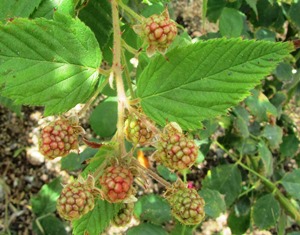Get Ready for Blackberry Season
Southwest of the farmette lie the Santa Cruz mountains where blackberries grow wild. I know because I lived in those mountains and for many years hiked the environs of the mountain towns of Ben Lomond, Boulder Creek, Felton.
Nestle in the foothills, Los Gatos maintains Vasona Park where blackberries grow wild along the hiking/biking trail near a creek. I’ve been there several times this summer. Invariably, when I walk the trail in August or September and taste a ripe, freshly-picked blackberry, the sweetness and sprightly flavor evoke happy memories of summers past.
Our Henny Penny Farmette is located an hour and a half north of the Santa Cruz Mountains. Here we are situated in the shadow of Mount Diablo, but we have the kind of climate blackberries love. What is lacking is ample water that the plants need to thrive.
Blackberries require a deep soil and here we have clay (which can suffocate the berries because of the lack of good drainage the roots need). But we’ve helped the berries along by aerating and amending the soil with nutrients and with ground corn cob, aged horse manure, and compost.
Our trailing blackberries grow supported on a trellis. Use a two-wire trellis to avoid bending the canes too severely and to enable intertwining of the canes.
Last year, we planted a few of the semi-erect thornless berry vines. The Evergreen and Thornless Evergreen are commercial varieties and are extremely productive. The berries are large, black, firm, and sweet, pretty much perfect for eating out of your hand or using in a cobbler or pie. You can also make jam with blackberries alone or in combination with other fruits.
Some varieties can be so prodigious and hardy, adapting to the wild, that they are considered in some states and counties as noxious weeds, or pests. One species is the Himalaya cultivar. Its berries are shiny, black, about 1-inch long and the vines produce fruit with medium to large seeds. It quickly spreads and is difficult to control and eradicate.
The season for ripened blackberries is still a few weeks away, but watch for vines in the wild or plant some in your garden. Fall to spring is the best time for planting most berries.
Check with your local garden center for the right time to plant in your garden zone. Blackberries are perennial so the roots survive for many years, especially if the soil is loamy, well drained, and located in full sun to partial shade. For more information, see http://www.weeksberry.com/berryfiles/files/Blackberry.pdf.
Wisteria Adds Drama to an Arbor or Trellis
I love the look of an arbor or trellis that makes a classical architectural statement in the garden. My husband Carlos has built a few of these. Most recently, he created a lovely trellis to support a decades-old wisteria that a neighbor had been growing in her garden.
Wisteria is a deciduous vine, meaning it loses its leaves in the winter and goes dormant. These vines are long lived, can be quite thick in diameter, and have lovely bracts of flowers in the spring, even before they sprout leaves.
It’s best to purchase wisteria that has already been grafted onto root stock or that has been grown from a cutting. These vines aren’t particular about soil, but they do need plenty of water and good drainage.
The other requirements are pruning and training. Wisteria can grow as much as 20 to 30 feet during the first year. I had a plant in San Jose that climbed a trellis and spilled over onto the roof in its very first year in that location.
I like tying the vines and the streamers to support them. Wisterias can be trained as shrubs (albeit large ones) or even as small trees. If planted on a bank or berm, they can spread quickly to vigorously cover the area.
I grew Wisteria floribunda in my San Jose garden, but here I’ve chosen Wisteria senesis (Chinese Wisteria) for the Henny Penny Farmette patio arbor (that we have yet to install). Chinese Wisteria blooms all at once in a beautiful violet-blue color before it leafs out in April-May. The blooms, which are more spectacular than the Japanese wisteria, are only marginally fragrant.
There is another variety of wisteria–Wisteria venustra–known as silky wisteria. The flowers are very large, long-stalked, and white. The plant blooms in short, heavy clusters that open all at once. Leaves break open in April. Another cultivar–Wisteria violacea has purple-blue flowers that are quite fragrant.
If you already have an amazing trellis or arbor, why not plant a wisteria next to it to add drama to your garden? It’s a vine sure to please year after year with ever-more spectacular blooms.
 Facebook
Facebook Goodreads
Goodreads LinkedIn
LinkedIn Meera Lester
Meera Lester Twitter
Twitter


